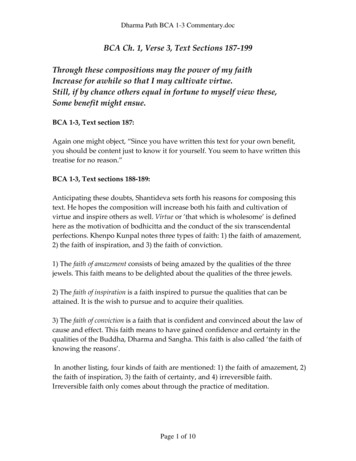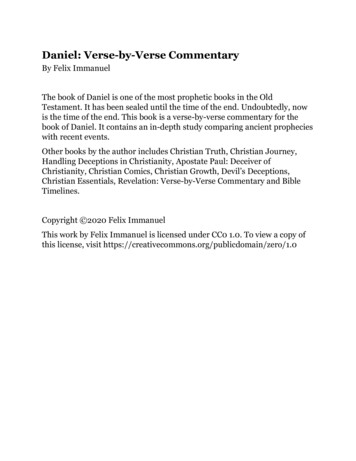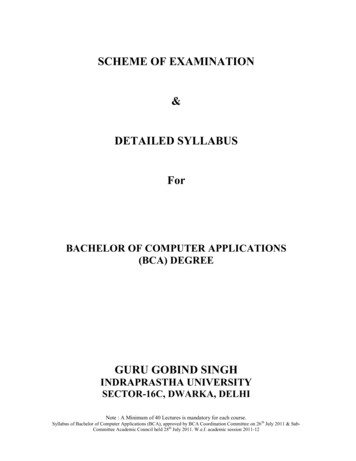
Transcription
Dharma Path BCA 1-3 Commentary.docBCA Ch. 1, Verse 3, Text Sections 187‐199Through these compositions may the power of my faithIncrease for awhile so that I may cultivate virtue.Still, if by chance others equal in fortune to myself view these,Some benefit might ensue.BCA 1‐3, Text section 187:Again one might object, “Since you have written this text for your own benefit,you should be content just to know it for yourself. You seem to have written thistreatise for no reason.”BCA 1‐3, Text sections 188‐189:Anticipating these doubts, Shantideva sets forth his reasons for composing thistext. He hopes the composition will increase both his faith and cultivation ofvirtue and inspire others as well. Virtue or ’that which is wholesome’ is definedhere as the motivation of bodhicitta and the conduct of the six transcendentalperfections. Khenpo Kunpal notes three types of faith: 1) the faith of amazement,2) the faith of inspiration, and 3) the faith of conviction.1) The faith of amazement consists of being amazed by the qualities of the threejewels. This faith means to be delighted about the qualities of the three jewels.2) The faith of inspiration is a faith inspired to pursue the qualities that can beattained. It is the wish to pursue and to acquire their qualities.3) The faith of conviction is a faith that is confident and convinced about the law ofcause and effect. This faith means to have gained confidence and certainty in thequalities of the Buddha, Dharma and Sangha. This faith is also called ‘the faith ofknowing the reasons’.In another listing, four kinds of faith are mentioned: 1) the faith of amazement, 2)the faith of inspiration, 3) the faith of certainty, and 4) irreversible faith.Irreversible faith only comes about through the practice of meditation.Page 1 of 10
Dharma Path BCA 1-3 Commentary.docThe term to cultivate can also be translated as ’to meditate’, or ’to contemplate’. InKhenpo Kunpal’s commentary, it means ’to familiarize oneself with’ or ’to growaccustomed to’.To cultivate suggests meanings such as becoming ‘accustomed to’, ‘familiarwith’, or ’acquainted with’ the continuous maintenance of concentration, havingthe mind repeatedly focus on virtuous thoughts. This term is used in phraseslike ’cultivating faith’ or ’cultivating compassion’.Since ’to cultivate’, ‘to meditate’, and ’to become familiar with’ have the samebasic meaning, Tibetan translators use ’path of meditation’, ’path of cultivation’,or ’path of habituation’ to translate the Sanskrit term ’bhavanamarga’.You might ask why you should familiarize or accustom your mind to virtuousthoughts. The answer is that our minds have not been masters of themselvessince time without beginning. Rather, they are always dwelling in a state ofdependency. Our minds are constantly chasing after afflictions, which lead to thedevelopment of all sorts of defects and mistakes. ’Cultivation’ or ’meditation’means bringing such a mind under your own power of mastery and directing ittoward whatever virtuous thoughts you wish.Writing a treatise such as the Bodhisattva‐caryavatara, or expounding the text toothers, leads to an increase in the three kinds of faith because you are thenfocusing your attention on the buddhadharma, which is virtuous. On the otherhand, if you place your attention on something negative, your unwholesometendencies, such as aggression, will increase.A mere intellectual understanding of the words of this treatise will not bringforth genuine bodhicitta and thus will not lead to a decrease in afflictions.Superficial study is not enough. Without intensive study, whatever a studentlearns will be easily forgotten. Topics like the preciousness of human existenceand the benefits of bodhicitta must be repeatedly and constantly kept in minduntil heartfelt conviction arises. Only through constant familiarization with theDharma will faith and virtue increase. When familiarization is perfected, the truemeaning of bodhicitta will clearly manifest.Mingle your mind with this treatise. Faith and devotion are mental acts, whilerespect refers more to body and speech. Faith and devotion purify your mind.Faith in itself is a pure thought. A mind infused with faith and devotion is a puremind. Faith, devotion and a virtuous mindset are the roots of all healing powers.Page 2 of 10
Dharma Path BCA 1-3 Commentary.docA virtuous mind is the source of all happiness. Virtue refers to positive action inbody, speech and mind. If you live your life according to the Buddhist teachingson virtue, you will always feel bliss in your mind and physical body. Virtue isalso the key to social harmony. What follows are the most basic instructions onvirtue and how to develop a virtuous mind.Study the scriptures of the Buddha, rely on a spiritual friend, and associateyourself with noble friends. Do not inflict any harm on others, and practice theten virtuous actions.Avoid engaging in any of the ten non‐virtuous actions: taking life, taking what isnot given, sexual misconduct, speaking lies, sowing discord, harsh words,worthless chatter, covetousness, wishing harm to others, and wrong views.Avoiding taking life means not to kill any sentient being. Avoiding taking whatis not given means not to steal. Avoiding sexual misconduct means not to take apartner who is in a relationship with someone else. Avoiding speaking liesmeans not to twist people’s minds through untruthful statements.Avoiding sowing discord means not to drive people apart through vicious talk.Instead, bring people together through harmonious and friendly ways of talking.Avoiding speaking harsh words means not to speak in an unkind way to others.Always use soft and gentle language. Avoiding worthless chatter means to notwaste your time talking nonsense.Avoiding covetousness means taming the desire to obtain and possesseverything you see. Learn to be content with whatever material goods you have.Avoiding wishing harm to others is a most important point. You should alwayswish good things for other people. Wish everyone well, even people who havecaused you harm. Finally, avoid wrong views. Do not hold the wrong view thateverything will come to an end with your death.Trust in karma, the law of cause and effect. Know that all your thoughts andemotions, words and actions have consequences. Understand that good actionslead to good results and bad actions to bad results. Know that your mind willtake rebirth repeatedly until you achieve enlightenment. The correct universalview means to believe in karma and to avoid the ten negative actions.Page 3 of 10
Dharma Path BCA 1-3 Commentary.docTulku Urgyen taught that practitioners should tame their harmful intentions byapplying the sutra teaching on ’training in goodness in four ways’:Although accused, do not respond with accusation.Although attacked, do not respond with aggression.Although beaten, do not strike back.Although exposed, do not respond by exposing others.You might be falsely blamed for something terrible. You might be accused ofsomething bad you did not do or say. A yogin does not respond to accusation bysaying, “I didn’t do it.” He does not retaliate by accusing others. When anger oraggression comes at him, he never answers with aggression. However harsh thewords may be, however bold the aggressor, the yogin does not become upset.Even if physically attacked and beaten, a yogin will never hit back; he will sitwhere he is, taking the beating silently. As long as the yogin is on the path, he isnot free from defects. So, when someone exposes his faults, he does not becomeupset or defensive. He might say, “What you observe is true. I am at fault.”If you apply these points, you will have no enemies; you will not be a target foraggression. Whatever bad things might be said or done to you will cause noharm. As you do not respond to negativity, people will tire of trying to pickfights with you. Train yourself and try to accomplish this much patience. If youstick to these points, you may be called a practitioner. Give the gain to others andkeep the loss. Allow others to be right, even if it makes you wrong. This is howTulku Urgyen advised his students.Living according to these principles will make your entire being content andhappy. It does not matter whether you are rich or poor, famous or unknown. Thevery basis of a happy life is to live according to the discipline of avoidingnegative actions. It does not matter whether or not you are a Buddhist. This is thevery basis for happiness.Students of Buddhism need to know one very important point. If you want toacquire knowledge and wisdom, you must first become a proper vessel, capableof holding and absorbing this kind of knowledge. The vessel is discipline. Theminimum discipline required is the discipline of avoiding the ten negativeactions. Such a vessel of discipline will be able to hold knowledge and wisdom,leading to samadhi.Page 4 of 10
Dharma Path BCA 1-3 Commentary.docDiscipline means making a commitment or pledge. You must pledge to live bythe ten virtuous actions. Only then are you practicing discipline. The thought, “Iwill live by the ten virtuous actions and avoid the ten non‐virtuous actions evenat the cost of my life” generates inconceivable merit. Remind yourself of thispledge a few times every day. Your Dharma study will then be successful. Whatyou actually aspire to is a complete transformation of your entire being.BCA 1‐3, Text section 190:To live straightforward in the conduct of the bodhisattvas means ’to live honestly’.BCA 1‐3, Text sections 191‐192:Some people who are overly timid may think, “I cannot do this. It’s all toodifficult for me. I simply don’t have the confidence necessary to practice likethat.” Such a timid attitude will prevent you from practicing the Dharma, and,therefore, virtuous qualities will never arise. An overly timid mind is a realobstacle for practicing the Dharma.Dharma students must develop an uplifted and joyous state of mind, a mind thatis enthusiastic and inspired. When two countries are on the brink of war, thegenerals like to fire up their soldiers with speeches, music and marches. Throughthat the soldiers develop courage. That is what is meant by ’uplifting one’s mind’.The Pitaputra‐samagamana‐sutra recounts the story of how the Buddhaestablished his father, King Suddhodana, in the Dharma. Khenpo Chogarecounted this story in the following way: Because Suddhodana was a king andalso the Buddha’s father; he was a very proud person. He thought, “Gautama ismy son. I will not prostrate to him.” As he was so swollen with pride, he couldnever receive teachings from the Buddha.One day, while the Buddha was teaching at a certain place, King Suddhodanawent to see what was going on. As he approached, he saw the ’four greatguardian kings’ protecting the area. The four great guardian kings told KingSuddhodana, “Today, the Buddha will teach the Dharma to the ’thirty‐threegods’ as well as to us four great guardian kings. Human beings are not allowedto join the teachings.”King Suddhodana thought, “I, the king, pay respect to the ‘the thirty‐three gods’.Now the gods are receiving teachings from my son, the Buddha.” He began toPage 5 of 10
Dharma Path BCA 1-3 Commentary.docsee how very arrogant his attitude had been. Humbled in this way, he finally wasable to prostrate to the Buddha, and so the Buddha established him in theDharma.BCA 1‐3, Text section 193:The four prerequisites of declaring respect, pledging to compose, casting awaypride, and generating joy are not only needed for composing treatises but arealso required for whatever task one may undertake, be it teaching, studying,meditating, building a temple and so forth.Before you set out on any undertaking, you should first offer prostrations andsupplicate the Buddhas and lineage masters in order to receive their blessings.This will remove all obstacles for your project and is especially important whenpracticing meditation. Without supplicating the masters, you will not receivetheir blessings, and your meditation will not lead to realization. This is a crucialpoint. Without heartfelt devotion, the blessings of the lineage will not descend,and realization will not dawn without the blessings of the lineage.The second step for any undertaking is to give rise to the firm resolve to see yourproject through to completion. Such resolve is also indispensable for meditation.At the beginning of each session one should generate the resolution to be non‐distracted for the entire session.Next, you must overcome pride and arrogance without overcompensating bybecoming timid. As long as you consider yourself superior to others, you cannotappreciate other people’s qualities, and, therefore, you cannot learn from them.Meditators who think their practice is really fantastic have already fallen underthe influence of Mara. A practitioner should have confidence in his practice butwithout a trace of arrogance and haughtiness. True confidence leads to theassurance of charisma.A practitioner needs to respect him or herself. Someone who rejoices in his ownqualities and in the work he does will naturally develop respect toward himself.A practitioner who has respect toward his own innate goodness and in thegoodness of his Dharma practice will naturally gain the respect of others.It is a sign of a genuine practitioner to be peaceful, tame, and relaxed. Such apractitioner is in accord with the true nature of his mind. Being proud andPage 6 of 10
Dharma Path BCA 1-3 Commentary.docarrogant means not being in accord with one’s true nature. A genuinepractitioner is humble as he has nothing to defend. Being humble does not meanto be meek or fearful. Being meek and frightened is based on fear. To trust andrejoice in one’s own qualities and innate goodness is called confidence orcertainty. This should never be confused with pride or arrogance.A practitioner should always rejoice in his Buddha nature, the fact that he isprimordially endowed with all the infinite qualities of the Buddha. This is calledto ‘generate joy in one’s basis’, in one’s Buddha nature. When practicing the pathof Dharma, the practitioner should generate joy in his own Dharma practice. Heshould practice with a joyous mind, knowing that he is doing the right thing.That is called to ‘generate joy in the path’.These four prerequisites of 1) declaring respect, 2) pledging to compose, 3)casting away pride, and 4) generating joy can be applied to any project or workbut should be practiced particularly when studying, contemplating andmeditating.BCA 1‐3, Text section 194:The four interrelated aspects such as the purpose and so forth are also called ’thefourfold interrelated purposes’. When these four interrelated aspects are present,one will enter into the study of a treatise, since the treatise promises to bemeaningful.The aspects are: 1) the topic, 2) the purpose, 3) the ultimate purpose, and 4) therelation between them. The first stanza of the first chapter demonstrates thesefour aspects:To the Sugatas, who are endowed with the Dharmakaya,together with their sons, and to all who are worthy of veneration,I respectfully pay homage. That done, in accordance with the scriptures, Iwill briefly explain entering into the precepts of the sons of the Sugatas.1) The third line in the first stanza in Tibetan indicates the topic of theBodhisattva‐caryavatara: “Entering into the precepts of the sons of the Sugatas”.This line belongs to the section known as ’pledging to compose’ the text, thesecond of the four prerequisites. By stating the topic of the treatise, the authortells the reader what the text is about.Page 7 of 10
Dharma Path BCA 1-3 Commentary.doc2) The overall purpose of the Bodhisattva‐caryavatara is laid out in the followingline from the first stanza: “In accordance with the scriptures, I will brieflyexplain .” This line also belongs to the section on ’pledging to compose’ thetext.The Bodhisattva‐caryavatara is a treatise which gathers what has been dispersedas well as being a treatise for the practice of meditation. Therefore, it will bemeaningful and beneficial to anyone who reads it. This is the Bodhisattva‐caryavatara’s real purpose, to condense all the teachings of the Buddha into onesingle treatise.3) The ultimate purpose of the Bodhisattva‐caryavatara is spelled out by this linefrom the first stanza: “The Sugatas, who are endowed with the Dharmakaya,together with their sons ” The ultimate purpose is to achieve the level of theSugata, ’the one gone to bliss’, who is endowed with the Dharmakaya. This linebelongs to the section called ’declaration of respect’, the first of the fourprerequisites. Through the practice of the Bodhisattva‐caryavatara one will beable to achieve the level of the Sugatas, endowed with the Dharmakaya. Thisultimate purpose reveals the goal to which the Bodhisattva‐caryavatara leads.4) The relation between these: The latter aspects cannot exist without the former.First, you state the topic of the text; next, you state its purpose. Finally, youindicate where it is leading, the ultimate purpose. Lacking a topic, whatever youproduce will not be meaningful to read. Without something meaningful to studyand learn, you cannot reach the ultimate fruition, the Dharmakaya. Theinterdependent relation of the three previous aspects is only implied in the roottext. It is not explicitly stated as the relationship is obvious.In this way, the latter aspects are dependent on the former. If you do notunderstand the conduct of the bodhisattvas, you cannot understand the vastteachings of the Buddha, and without the Buddha’s teachings you cannot reachenlightenment.BCA 1‐3, Text section 195:These four aspects enable the reader to approach the treatise with trust and,moreover, with an inquisitiveness that searches for meaning.One can approach a treatise fearing that it might be insignificant or with aninquisitiveness into its possible significance. The first is fear concerning itsinsignificance, when one thinks, “This treatise probably lacks a topic, a purpose,Page 8 of 10
Dharma Path BCA 1-3 Commentary.docan ultimate purpose and a relation between these.” The latter is theinquisitiveness concerning its significance, when one thinks, “This treatiseprobably has a topic, a purpose, an ultimate purpose and a relation betweenthese.”In other words, you could think, “I wonder if reading this text might really bemeaningful and beneficial for me. Maybe I will find some answers to mypersonal questions in this text.” You should have an open and critical frame ofmind, one searching for meaning. Inquisitiveness that searches for meaning cutsthrough doubts leads to a state free from any doubts. The Buddha always invitedeveryone to scrutinize his teachings. Only through addressing one’s problemsand analyzing them will one gain insight. The Bodhisattva‐caryavatara teachesthe methods for doing exactly that.In this way, the four aspects prevent people from entertaining wrong ideas, suchas thinking, “The Bodhisattva‐caryavatara might be just a useless treatise, likesome treatise on the dentistry of crows.” And finally, these four aspects enhancethe beauty of the text.An intelligent person will immediately know if a treatise is endowed with thesefour aspects. If a treatise should lack them, the reader will recognize it as uselessand not even bother to continue reading.BCA 1‐3, Text sections 196‐197:This aspiration summarizes the entire Bodhisattva‐caryavatara. The Bodhisattva‐caryavatara has ten chapters in 913 stanzas.The ten chapters are structured according to four main classifications:Three chapters that give rise to the precious bodhicitta in those in whom it hasnot yet arisen (chap. 1, 2, 3):1. Chapter one, explaining the benefits of bodhicitta (36 stanzas)2. Chapter two, confessing negativities (65 stanzas)3. Chapter three, thorough adoption of bodhicitta (33.5 stanzas)Three chapters that prevent the decrease (of the precious bodhicitta) where it hasarisen (chap. 4, 5, 6):4. Chapter four, heedfulness (48 stanzas)5. Chapter five, introspection (109 stanzas)6. Chapter six, patience (134 stanzas)Page 9 of 10
Dharma Path BCA 1-3 Commentary.docThree chapters that not only prevent the decrease (of the precious bodhicitta) butcause it to ever increase more and more (chap. 7, 8, 9):7. Chapter seven, diligence (76 stanzas)8. Chapter eight, meditation (187 stanzas)9. Chapter nine, transcendental knowledge (167 stanzas)A single chapter concerning the dedication of the results that have thus beendeveloped for the benefit of others (chap. 10):10. Chapter ten, Dedication (57.5 stanzas).Following this format of structuring the whole Bodhisattva‐caryavatara, the firstthree chapters deal with arousing bodhicitta. The second three chapters deal withhow to sustain bodhicitta and prevent it from being lost or diminished. The thirdthree chapters deal with methods for increasing bodhicitta. The tenth chapterdeals with the subject of dedication. You dedicate the benefits of bodhicittawhich you have aroused, sustained and increased through the teachings of theprevious nine chapters.Looking carefully at Khenpo Kunpal’s table of contents you will find all themajor sections and sub‐sections of the Bodhisattva‐caryavatara. If you applythese various headings to the root text, you will have already gained a great dealof insight into the meaning and interpretation of the text.The first chapter of the Bodhisattva‐caryavatara explains the benefits or qualitiesof bodhicitta. The word benefits suggest ’helpful qualities’. This chapter is awonderful advertisement for bodhicitta, just as these days televisioncommercials advertise the qualities of a product. If people do not hear about thequalities and benefits of bodhicitta, they will never aspire to generate it in theirminds.As soon as one understands bodhicitta’s inconceivable qualities, however, onewill certainly think, “I need these teachings on how to develop bodhicitta.”Generally, treatises list the qualities of the topic under discussion at the end ofthe text. Shantideva is here more intelligent, keen as he is to advertise thequalities of bodhicitta right at the text’s beginning. If someone is sick and hearsabout appropriate medicine which will cure him, he will certainly follow hisphysician’s advice and take the medicine at once.Page 10 of 10
Still, if by chance others equal in fortune to myself view these, Some benefit might ensue. . Faith and devotion purify your mind. Faith in itself is a pure thought. A mind infused with faith and devotion is a pure mind. Faith, devotion and a virtuous mindset are the roots of all healing powers. .










